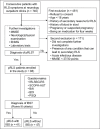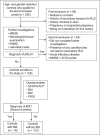Patients with primary restless legs syndrome have higher prevalence of autonomic dysfunction and irritable bowel syndrome
- PMID: 29372261
- PMCID: PMC6199186
- DOI: 10.11622/smedj.2018010
Patients with primary restless legs syndrome have higher prevalence of autonomic dysfunction and irritable bowel syndrome
Abstract
Introduction: Given the limited data on autonomic dysfunction in patients with primary restless legs syndrome (pRLS), we compared autonomic dysfunction and presence of irritable bowel syndrome (IBS) between patients with pRLS and control patients.
Methods: Consecutive adult drug-naïve patients with pRLS, and age- and gender-matched healthy control patients were enrolled in this study. Diagnoses, based on validated self-reported questionnaires, were made using the following guidelines: Rome III classification system for functional gastrointestinal disorders for IBS; Beck Anxiety Inventory (BAI) and Beck Depression Inventory (BDI) for the presence of anxiety and depression, respectively; Pittsburgh Sleep Quality Index (PSQI) for severity of sleep disturbances; and Scales for Outcomes in Parkinson's disease-Autonomic (SCOPA-AUT) for autonomic dysfunction.
Results: There were 88 patients with pRLS (18 male, 70 female) and 128 control patients (40 men, 88 women). The mean age of the pRLS patients and control patients was 50.3 ± 9.3 years and 49.7 ± 8.2 years, respectively. Overall, 41 (46.6%) of the patients with pRLS and 16 (12.5%) of the control patients had IBS. Among patients with pRLS, IBS was significantly more common and the total autonomic SCOPA-AUT scores were higher than those found among control patients. Among pRLS patients with IBS, total autonomic SCOPA-AUT, PSQI, BAI and BDI scores were significantly higher than among pRLS patients without IBS. The presence of IBS did not affect the severity of restless legs syndrome.
Conclusion: The presence of autonomic nervous system impairment in patients with pRLS and the strong link between IBS and pRLS merit further, more extensive investigation.
Keywords: IBS; RLS; SCOPA-AUT; autonomic dysfunctions.
Copyright: © Singapore Medical Association.
Figures


References
-
- Benes H, Walters AS, Allen RP, Hening WA, Kohnen R. Definition of restless legs syndrome, how to diagnose it, and how to differentiate it from RLS mimics. Mov Disord. 2007;22(Suppl 18):S401–8. - PubMed
-
- Allen RP, Walters AS, Montplaisir J, et al. Restless legs syndrome prevalence and impact: REST general population study. Arch Intern Med. 2005;165:1286–92. - PubMed
-
- Gosselin N, Lanfranchi P, Michaud M, et al. Age and gender effects on heart rate activation associated with periodic leg movements in patients with restless legs syndrome. Clin Neurophysiol. 2003;114:2188–95. - PubMed
-
- Pennestri MH, Montplaisir J, Colombo R, Lavigne G, Lanfranchi PA. Nocturnal blood pressure changes in patients with restless legs syndrome. Neurology. 2007;68:1213–8. - PubMed
MeSH terms
LinkOut - more resources
Full Text Sources
Other Literature Sources
Medical

